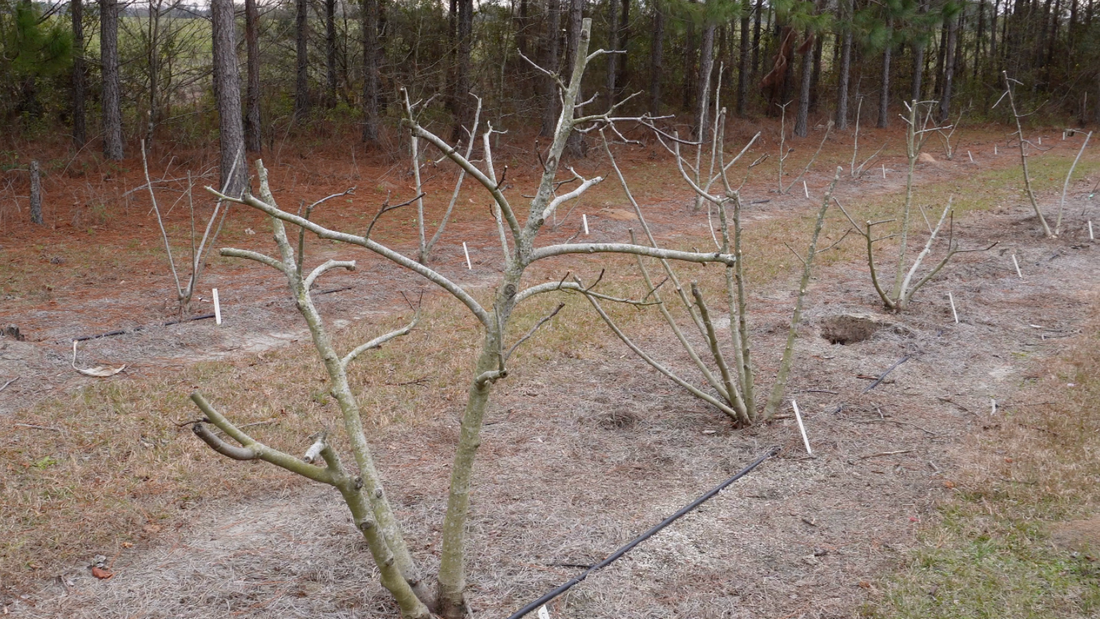Although all our fig trees are bare right now (mid January) as I'm writing this, it won't be long before they're budding and growing again. Here in south Georgia, fig trees can start budding as soon as late February.
Our fig trees always seem to bud several weeks before our last frost. But unlike other fruit trees, a late frost doesn't bother the fig production down the road. It may burn back the leaves a little, but it doesn't slow them down much.
Now is a great time to take care of some winter housekeeping items on your fig trees. Below we'll list some of the things we'll be doing in our fig orchard over the next couple weeks to get ready for spring growth.
Winter Fig Tree Housekeeping Items
1) Pruning
This is something that we usually do once our trees go dormant in early winter. Some growers like to wait until late winter to prune their fig trees, but I like to go ahead and get it finished when I can. Pruning not only helps keep your trees more manageable, but it helps promote more new growth in the spring. I won't cover more about pruning here because we've discussed that thoroughly in other blogs and videos on our YouTube channel.

2) Checking Irrigation
We're big believers in having a drip irrigation system in our garden plots and our fig orchard. Since we installed our fig orchard irrigation system a few years ago, we have seen significantly more growth from our trees each year. It also increases the survival rate of young trees that can become stressed in the middle of the summer down here.
Although our irrigation system is pretty simple, we still need to make sure that all our emitters are still attached to the mainline and that they're all working properly. This is much easier to do in the winter when the trees have no leaves and the base of the trees is easier to access.
We'll basically turn on our fig orchard irrigation system and walk down the rows to check each tree. We like to keep a set of pre-assembled fittings on hand so we can easily plug and play to replace where needed. Once we ensure that the dripper on every tree is working properly, we're ready for step three.
3) Fertilization
We inject AgroThrive Fruit and Flower through our irrigation system once our trees start growing in the spring, but we also like to give them granular fertilizer now. This is much like the "pre-plant" fertilizer we apply in our vegetable gardens at planting. It ensures there are sufficient nutrients in the soil when seeds germinate or transplants start growing. In this case, those nutrients are there for the fig trees when they start budding.
I recommend using a balanced fertilizer for this. We use our Coop Gro fertilizer, but you could use 10-10-10 or a similar synthetic fertilizer analysis. Liberally sprinkle the fertilizer around the perimeter of the tree, making sure to cover a wide ring.
If you've got older fig trees, don't be shy with the fertilizer. They can take as much as you want to give them. You do have to be a little more careful with younger fig trees though. I usually only give the 1-2 year old trees a couple handfuls.

4) Adding Mulch
We use pine straw down the rows in our fig orchard and have grass lanes between each row. The pine straw makes orchard maintenance easy during the growing season because we don't have to mow or weed-eat around each individual fig tree. I like to put down a fresh new layer of pine straw each year to suppress weeds along the rows in our orchard, and we'll be doing that in the next couple weeks as well.
5) Dormant Spray
Here in the hot and humid south, our fig trees are prone to getting rust on the leaves in the warmer months. This rust doesn't hurt the trees, but it does make them lose their leaves. After losing the leaves, they'll make new growth and new leaves for a second or third crop of figs.
While it's unlikely that we could eliminate fig rust completely, we can mitigate the rust and minimize the damage somewhat. We can do that by spraying our trees with a fungicide that helps combat the rust. You don't way to spray fig trees when they're loaded with figs, but you can apply a fungicide when they're dormant and before figs start forming.
There are lots of good options for a dormant spray on fig trees, including neem oil, copper fungicide, and several other fungicides labeled for fig trees. We'll be using our BugHut Plant Booster which contains a beneficial bacterial (Bacillus amyloliquefaciens) to help combat the rust.
The beneficial bacteria in this formulation colonize the tree surface and root zone to competitively exclude harmful fungi and other "bad guys." We'll apply a dormant spray now and another in mid-February. We'll then do a final application in March or April before figs start forming.

Take the Time and You'll Be Rewarded
These cooler days are a perfect time to take care of some of these items on your fig trees. It doesn't take long, and it will go a long way to ensuring success and better harvests for your trees the following spring. Here's to a great 2024 fig season for all of us!

